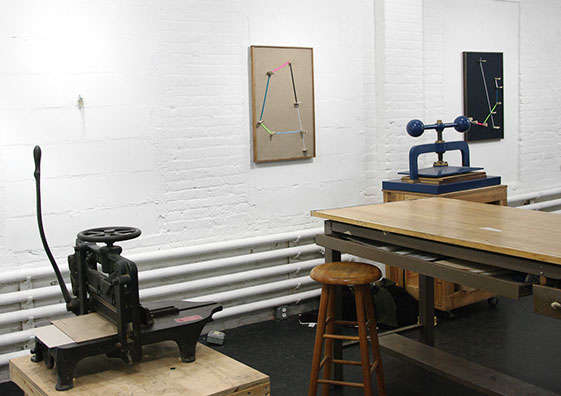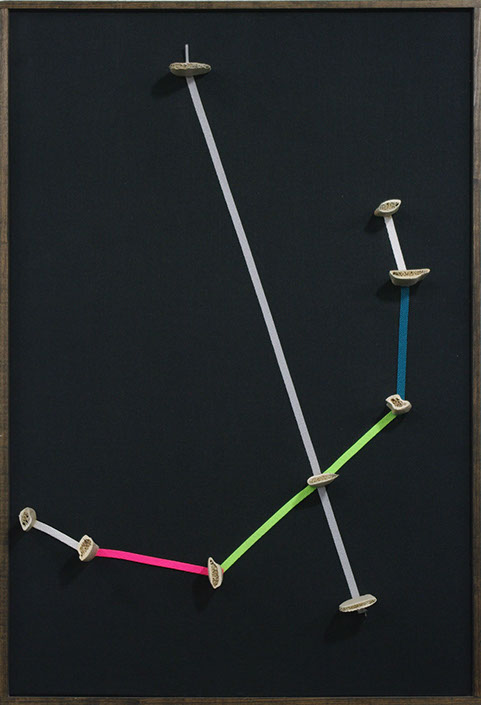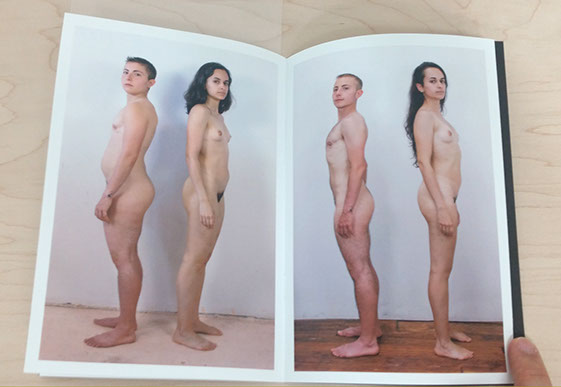

Endless Care Installation shot
photo: Scott Robinson
Endless Care @ Small Editions
Small Editions is primarily a center for creating and promoting artist books. However, the cozy workspace –with its painted white brick walls and pressed tin ceiling– is also a space for artists to exhibit work. Endless Care, curated by artist Sheryl Oppenheim, inhabits the space effortlessly. A sense of labor exists in the surfaces of the worktables, the machinery, and the old brick walls which corresponds to an ethic of authenticity present in the artwork.
In the press release, Oppenheim quotes Jan Verwoert and his idea of care: “...you perform because you care for someone or something. This care gives you the strength to act, not least because to not act is out of the question when someone or something you really care for or about requires that you should act”. The work in this show wasn’t motivated by ego. Care is the impetus for action, making and creating. Anthony Huberman posits that artists should think in terms of “I care” or “I love” rather than “I get it”1. In this way, many of the works in Endless Care appear to have been made by artists who have forethought rather than a desire for "answers".
Sun You’s installation pieces tread the line between chance and exactitude. An open safety pin will balance upright on a small brass hook. The area of contact between each object is remarkably minute –they look like they are magically bundled together. Sun You is the Judy Phaff of the micro. From significant viewing distances, the distinctions between items vanish. Because of their small size and delicate nature (one piece features a

Sun You, Untitled (2014)
mixed media
dimensions variable
dead leaf which looks like it could crumple to pieces with one touch), the sculptures function best when approached individually; a viewing experience reminiscent of my time spent with the Tomma Abts pieces at David Zwirner. Even the diagonals on the carefully re-configured paper clips pick up a similar particularity in chance composition. Abts’ paintings were not meant to be seen all at once, as a small space requires, but Sun You’s little bundles are playfully scattered on the wall creating a drawing-like composition. Because most are fastened to the wall by the very material that comprises each piece, the surface of a wall is as important to her work as the paper is to a drawing.

Sun You, Untitled (2014)
mixed media
dimensions variable
Towards the back of the gallery, the viewer is met with stylized drawings of hearts and hands cast within shimmering resin; collaborative pieces by Paul DeMuro and Steven Mayer. Collaboration requires trust with a willingness to forgo expectations –especially in the call and response fashion the artists created their two pieces. The work has a sparkle nail polish sort of gaudiness that simultaneously attracts and repulses. The more you linger, the more the object unfolds. They are exquisitely crafted. Jewel tones of the resin coincide with those in the drawing. The drawing appears to undulate under the surface like fish in a frozen pond. The hands bring to mind early cave drawings, Pre-Renaissance forms and religious iconography. Narrative symbols leads the viewer to read the plaques like stories illustrated in stain glass windows. The plaques feel like sacred kitsch totems.

Paul DeMuro, Steven Mayer, Hearts Above (2014) (left) and Hands Below (2014) (right)
Acrylic, blue goldstone, eye shadow, marker, paper, pigment, resin, sand gel
15.75 x 23 inches (Hearts Above), 15.75 x 22.75 inches (Hands Below)
Andria Morales presents more personal narratives that directly confront social issues, especially in her work As You Change 2010+2104. In it, she documents her childhood friend’s transition from female to male. The photographic booklet presents the artist naked, standing with her friend, who is also nude. The two individuals are in neutral postures, sometimes joined palm to palm. At the book progresses, the friend’s body changes from female to male. The images are free of emotion and judgment: they honestly catalog a process, but more importantly document an effort to understand. The inclusion of a childhood photo of the two girls posing back to back in their band uniforms, indicates a nostalgia for an uncomplicated past. While the piece is deeply personal to the artist, it provides a platform for viewers to learn, question, and empathize with people who go through these changes.

Andria Morales, As You Change: 2010-2104 (2014)
Artist book, edition of 100
5 x 7.5 inches
Maul (2014) and Arc (2014) lend a sense of finality to the show. Ian Pedigo uses bone, shoe lace, burlap and wood to create austere compositions. “Constellations” are mapped on the burlap with bones representing stars and the neon lace marking the shape of each constellation. Despite his use of organic material, the pieces have a cold rigidity that results from a stringent and obsessive eye. The wonder of the cosmos is not directly transmitted, but rather impermanence and the passage of time. The endless nature of the cosmos corresponds to the restless production of artists who operate with sincerity.
1 Anthony Huberman, How to Behave Better, 2012 http://www.servinglibrary.org/read.html?id=9296
The lecture was given at Stroom Den Haag on Oct. 11, 2012
http://www.stroom.nl/activiteiten/lezing_symposium.php?l_id=1075959

Ian Pedigo, Arc (2014)
Bone, shoelaces, fabric, wood
21 x 31.25 inches
Endless Care
November 7, 2014 - January 10th, 2015
Small Editions
60 Sackett Street
Ground Floor/Double Yellow Doors
Brooklyn, NY 11231
Hours
Monday - Friday 10am-5pm

Andria Morales, As You Change: 2010-2104 (2014) detail
Artist book, edition of 100
5 x 7.5 inches
Disclaimer: All views and opinions expressed are those of the authors and do not necessarily reflect the views of the editors, owner, advertisers, other writers or anyone else associated with PAINTING IS DEAD.
